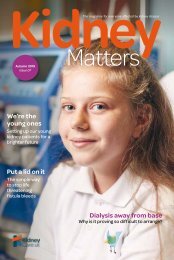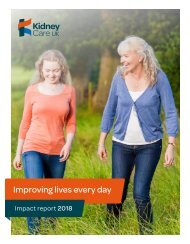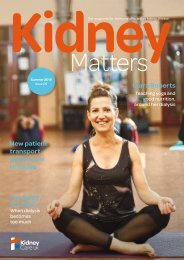Kidney Matters - Issue 10 Autumn 2020
Kidney Matters is our free quarterly magazine for everyone affected by kidney disease. This issue includes some advice on maximising your income, exploration of the role of exercise in chronic kidney disease, an article on hair loss stories and some stories from different people about their experiences of Covid-19. As well as this the we have an update on our Kidney Kitchen and a new chicken and vegetable crumble from Chef Ripley.
Kidney Matters is our free quarterly magazine for everyone affected by kidney disease.
This issue includes some advice on maximising your income, exploration of the role of exercise in chronic kidney disease, an article on hair loss stories and some stories from different people about their experiences of Covid-19. As well as this the we have an update on our Kidney Kitchen and a new chicken and vegetable crumble from Chef Ripley.
Create successful ePaper yourself
Turn your PDF publications into a flip-book with our unique Google optimized e-Paper software.
24
C O N T I N U E D
needles (or catheters) into their patients’ veins. They do this on a regular
basis whenever a fistula is blocked. So a major aspect of this technique was
already common practice in the UK. The next step was to travel to Paris to
observe the procedure being carried out in real-time.
Establishing the protocol in the UK
As Endo AVF surgery was a new pathway for fistula surgery in the UK, it had
to be scrutinised in the same way as any new pathway in medicine is, prior
to using it on patients. But once this process is completed, I know I can
confidently say to any patient, “This technique is safe and offers results
comparable to any open fistula surgery I can do for you.”
This said, we can’t guarantee that a patient will never require an opensurgery
AV fistula if they encounter problems in the future. We haven’t
been doing Endo AV fistulas for long enough to have compiled sufficient
data to support assertions like this. This means we can’t discount the
possibility that if an Endo AV fistula does not work for whatever reason, the
fall-back position will be an open-surgery AV fistula. It is vital that everyone
understand this. These are very early days.
The cost of the Endo AVF device may be a limiting factor in offering this
option to patients nationally. The more patients who ask for this procedure,
the more likely it is to receive the necessary approval by the National
Institute for Health and Care Excellence (NICE). So we do ask that patients
and patient groups voice their support so that Endo AVF may be made more
widely available.
The programme is launched
By the end of 2019 we were ready to select the patients who would have
this new fistula surgery. It was a very exciting time but we were also very
cautious as we counselled our first few patients.
Despite this, every one of our patients wanted to be the first to have an
Endo AV fistula. As clinicians, it was very reassuring to know that we had
our patients on board with us on this new journey. If you have patients
Figure 1: How does Endo AVF work?
Two thin, flexible
magnetic tubes or
catheters are inserted
into an artery and vein
in the arm through a
small puncture or cut.
When placed near
to each other, the
magnets attract,
pulling the blood
vessels together
and aligning the
radiofrequency (RF)
electrode in the
venous catheter.
The electrode delivers
a burst of RF energy to
create a connection
between the artery
and the vein. The
catheters are then
removed.
The deep brachial
vein in the upper arm
is then blocked via a
catheter. More blood
flows to veins near the
surface of the skin to
make them suitable
for dialysis.
An Endo AV fistula
kidneycareuk.org

















